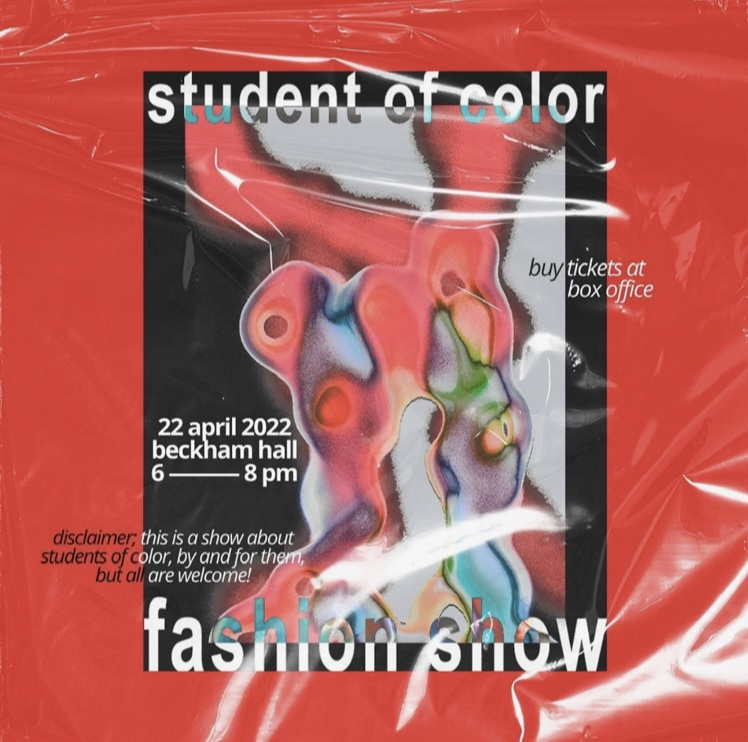
After a two-year hiatus due to COVID-19, the Student of Color (SOC) Fashion Show will return to campus at Beckham Hall on Friday, April 22 from 6 p.m. to 8 p.m. Student artists, designers, and models from a myriad of backgrounds have come together to put on the show, which is made by and for students of color.
The event is completely student-run under the direction of the SOC Fashion Show Committee and will consist of 12 lines by student designers. In the past, this event has also been a way to showcase students’ talent for incoming first-years during WesFest. Because of the changes to the WesFest schedule this year, admitted students will not be able to attend. Nonetheless, the show has been important in the past for students of color who visited campus.
“I [believed] we [should] try really hard to make the show happen because it was something that everyone liked,” designer and SOC Fashion Show board member Kelly Nano-Miranda ’23 said. “During WesFest, I saw a little snippet of it. I was like, ‘You have to make it happen.’ I think it was a really important thing for the student of color community.”
Earlier in the year, designers applied to showcase their work in the show by sharing their vision for their potential line and discussing the significance of the show at large.
“For the most part, we accept everyone who applies because there’s a [small] number of people who actually want to [make] that commitment,” Nano-Miranda said. “It is a pretty large commitment to make clothes, come to rehearsals, and oversee all your models.”
Each designer can showcase up to eight looks on the runway. While some student designers opted to create original clothing, others are outfitting their models in thrifted, found, or borrowed pieces. The organization received funding from the University to help designers achieve their goals and finance the minutiae of putting on the show.
“Admin gave us a budget of $1,800, and that money goes towards setting up lighting, setting up sound, paying photographers,” designer and board member Faijul Rhyhan ’23 said. “Each designer gets $120 for their budget, which is really good actually, because I feel like most people are thrifting stuff if they’re finding new pieces.”
That being said, it has been difficult for some designers to find space on campus to complete their work. While the Workshop studio in Hewitt Eight has been a helpful resource, some designers wished there was greater accessibility for those who do not have their own supplies.
“It’s actually been pretty stressful because there’s very few resources on campus for people to create clothing, especially if they’re a designer…but the workshops are a really good place where they provide you a lot of materials,” Nano-Miranda said.
Although fashion is the main event, students also decided to include other artistic elements, like music. Each designer created a music mix that will be played by DJ Joseph Godslaw ’23 as their models walk down the runway.
“The music definitely makes the show,” Rhyhan said. “If you were having people walk in really cool outfits but you [had] bad music playing, that might take away from it, but everybody will come through with really good mixes, and that’s going to be so exciting to see.”
There have also been additional ways that students have gotten involved in the show.
“I have been in charge of overseeing two lines of designs as well as designing and creating a pamphlet to archive and commemorate this year’s fashion show participants,” Minyoung Huh ’25 wrote in an email to The Argus. “It has been really exciting to see how this process goes and [meet] all the creatives putting their energy into the show.”
Some designers took the show as an opportunity to express their opinions on the fashion industry, with Rhyhan and Nano-Miranda deciding to comment on the industry’s exclusivity.
“[Our line] is called FJK and at the core of it…we understood that we both really like high fashion, but just don’t really like the exclusivity,” Rhyhan said. “There’s no reason these really cool designs should be exclusive [and] cost so much money. So we’ve been trying to have a DIY approach.”
Designer Jocelyn Velasquez Baez ’23 hopes to highlight the importance of being aware of the history behind designs, especially those associated with Indigenous cultures.
“I always advocate for people to buy from Indigenous businesses rather than buying from brands that culturally appropriate our designs and not give credit to the people that make them,” Velasquez Baez wrote in an email to The Argus. “[I hope to] show representation for and by Indigenous peoples in fashion, [in a way] that honors and celebrates their contribution such as patterns, beadwork, and quilt work. All the pieces in my line are handcrafted by various Indigenous groups across Mexico, Guatemala, and Ecuador.”
Velasquez Baez is working with models who have connections to Indigenous communities.
“[A]ll my models either identify with an Indigenous group such as Maya, Nahua, Mixteca, or Quechua, or are currently in their journey in connecting with their Indigenous roots,” Velasquez Baez wrote.
Models play an important role in the show because they offer a chance for students of color to walk and be seen in a space made for them.
“It’s been a bit scary knowing that so many eyes will be on me in person but it’s also a big confidence boost and pretty exciting,” model and makeup artist Kayla Penza ’24 wrote in an email to The Argus. “[B]eing on a platform is…confidence building once you know you can do this scary thing. I think it’s been a good opportunity to hype myself up and be a part of something larger than myself.”
Over 80 students applied to model in the show, and designers were given a model book to go through in order to choose those who fit their vision. The board hopes to make the organization inclusive even for people who weren’t able to model this year.
“Maybe in the future, we can create a show where we can have everyone included,” Nano-Miranda said. “I think it’s just hard because not a lot of people signed up to be designers.”
Nano-Miranda emphasized that having more designers participate in the show is significant because the University’s fashion culture often doesn’t represent students of color.
“Fashion is mostly concentrated or saturated with white fashion on campus,” Nano-Miranda said. “I just think that there’s not a platform for students of color to be seen.”
All 220 tickets to the show sold out within two days. The organizers are excited to finally be able to have in-person spectators after the three-year pause.
“I hope this show is a space for students of color to feel seen and appreciated as well as a way for us to connect with one another,” Huh wrote.
Nano-Miranda echoed this sentiment, recognizing the importance of having a space where students of color can celebrate together.
“The thing I’m most excited about is to see everyone all together,” Nano-Miranda said. “It’s a very rare feeling to feel comfortable on campus, a hundred percent…. I hope that this is just fun for people, especially our designers who worked so hard.”
The SOC Fashion Show is looking for new committee members, and interested students are encouraged to apply.
Lia Franklin can be reached at lfranklin@wesleyan.edu.



Leave a Reply